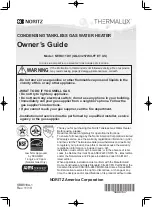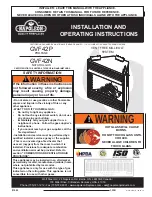
3
The location chosen for the water heater must take into consideration the
following:
LOCAL INSTALLATION REGULATIONS
This water must be installed in accordance with these instructions, local
codes, utility company requirements or, in the absence of local codes, the
latest edition of the National Electrical Code. It is available from some local
libraries or can be purchased from the National Fire Prevention Association, 1
Batterymarch Park, Quincy, MA 02269 as booklet ANSI/NFPA 70.
LOCATION
Locate the water heater in a clean dry area as near as practical to the area of
greatest heated water demand. Long uninsulated hot water lines can waste
energy and water. Place the water heater in such a manner that the front
panel can be easily removed to permit inspection and servicing such as
removal of elements or checking controls. The water heater and water lines
should be protected from freezing temperatures. Do not install the water
heater in outdoor, unprotected areas.
The water heater should not be located in an area where
leakage of the tank or connections will result in damage to
the area adjacent to it or to lower floors of the structure.
This water heater SHOULD NOT be installed in a space where
liquids which give off flammable vapors are to be used or
stored. Such liquids include gasoline, LP gas (butane and
propane), paint or adhesives and their thinners, solvents or
removers. Because of natural air movement in a room or
other enclosed space, flammable vapors can be carried from
where their liquids are being used or stored. The arc drawn
within the water heater's control can ignite these vapors
causing an explosion or fire which may result in severe burns
or death to those in range, as well as property damage.
Introduction
CAUTION
!
Installation
1. INSPECT SHIPMENT — Inspect water heater for possible damage.
Check the markings on the rating plate of the water heater to be
certain the power supply corresponds to that for which the water
heater is equipped.
2. THERMAL EXPANSION — Determine if a check valve exists in the
inlet water line. It may have been installed in the cold water line as
a separate back flow preventer, or it may be part of a pressure reduc-
ing valve, water meter or water softener. A check valve located in the
cold water inlet line can cause what is referred to as a
”closed water
system”. A cold water inlet line with no check valve or back flow
prevention device is referred to as an ”open” water system.
As water is heated, it expands in volume and creates an increase in
the pressure within the water system. This action is referred to as
”thermal expansion”. In an ”open” water system, expanding water
which exceeds the capacity of the water heater flows back into the
city main where the pressure is easily dissipated.
A
”closed water system”, however, prevents the expanding water
from flowing back into the main supply line, and the result of
”thermal
expansion” can create a rapid, and dangerous pressure increase in
the water heater and system piping. This rapid pressure increase
can quickly reach the safety setting of the relief valve, causing it to
operate during each heating cycle. Thermal expansion, and the result-
ing rapid, and repeated expansion and contraction of components in
the water heater and piping system can cause premature failure of
the relief valve, and possibly the heater itself.Replacing the relief
valve
will not correct the problem!
The suggested method of controlling thermal expansion is to install an
expansion tank in the cold water line between the water heater and the
check valve. The expansion tank is designed with an air cushion built
in that compresses as the system pressure increases, thereby relieving
the over pressure condition and eliminating the repeated operation of
the relief vale. Other methods of controlling thermal expansion are also
available. Contact your installing contractor, water supplier, or plumbing
inspector for additional information regarding this subject.
3. WATER SUPPLY CONNECTIONS — Refer to Fig. 2 for suggested
typical installation. The installation of unions or flexible copper con-
nectors is recommended on the hot and cold water connections so
that the water heater may be easily disconnected for servicing if
necessary. The HOT and COLD water connections are clearly marked
and are 3/4” NPT on all models. Install a shut-off valve in the cold
water line near the water heater.
IMPORTANT!! Do not apply heat to the hot or cold water connections. If
sweat connections are used, sweat tubing to adapter before fitting adapt-
er to hot or cold water connections on heater. Any heat applied to the hot
or cold water supply fittings will permanently damage them.
4. RELIEF VALVE — A new combination temperature and pressure relief
valve, complying with the Standard for Relief Valves and Automatic
Gas Shutoff Devices for Hot Water Supply Systems, ANSI Z21.22,
must be installed in the opening provided and marked for the purpose
on the water heater. (Refer to Fig. 2.) No valve of any type should be
installed between the relief valve and the tank. Local codes shall gov-
ern the installation of relief valves.
The pressure rating of the relief valve must not exceed 150 PSI, the
maximum working pressure of the water heater as marked on the
rating plate. The BTUH Rating of the relief valve must not be less than
the input rating of the water heater as indicated on the rating label
located on front of the heater (1 watt = 3.412 BTUH).
Connect the outlet of the relief valve to a suitable open drain so that
the discharge water cannot contact live electrical parts and to elimi-
nate potential water damage. Piping used should be of a type ap-
proved for hot water distribution. The discharge line must be no
smaller than the outlet of the valve and must pitch downward from
the valve to allow complete drainage (by gravity) of the relief valve
and discharge line. The end of the discharge line should not be
threaded or concealed and should be protected from freezing. No
valve of any type, restriction or reducer coupling should be installed
in the discharge line.
5. TO FILL WATER HEATER — Make certain drain valve is completely
closed. Open shut-off valve in cold water supply line. Open each hot
water faucet slowly to allow air to vent from the water heater and
piping. A steady flow of water from the hot water faucet(s) indicates
a full water heater.
WARNING
!






























